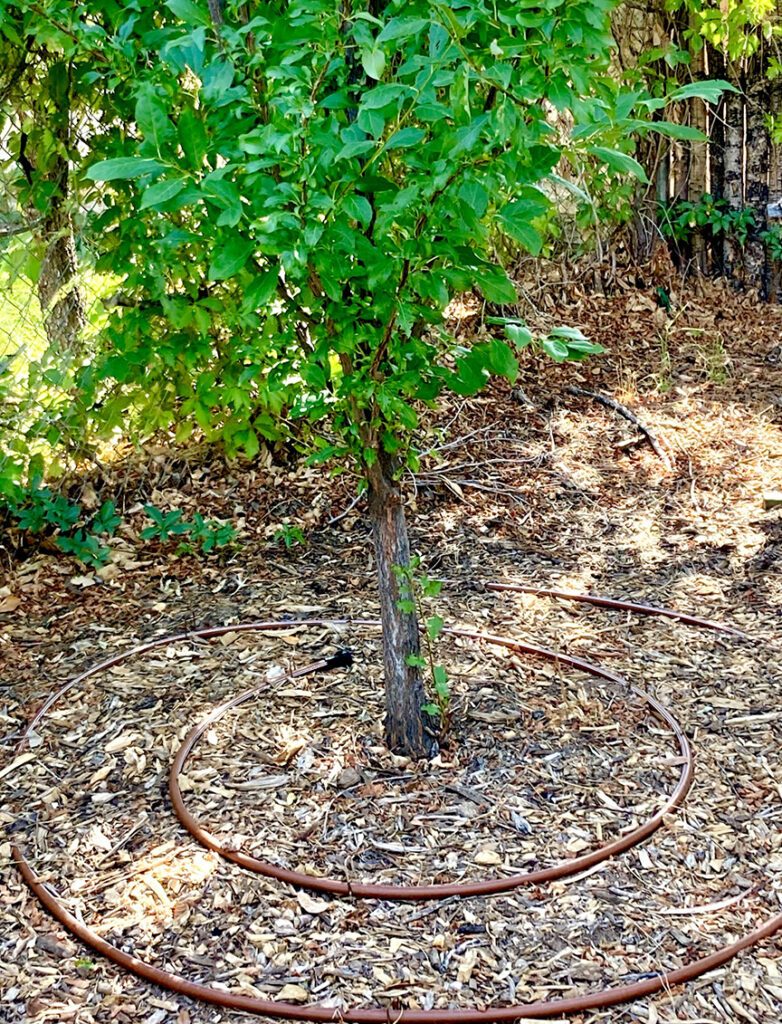Living in the desert, we all know how important water is for life. “Aqua es Vida” is the often heard refrain, and it applies to both humans and our whole ecosystem. As we plant trees, shrubs, vegetables, and flowers, there are many techniques for watering that differ according to the time of year, age of the plant, and its species. There is no one way which suits all nor do all the landscape folks agree on the best ways to water. This article provides some things to consider as you perfect your watering technique for outdoor plants.

First and foremost, when you first put a tree or shrub in the ground, be sure to water at the periphery of the pot line so the roots of your new plant are kept moist for at least the next two or three months.
Drip irrigation means black or brown ¼ inch lines with emitting holes six, nine, or twelve inches apart. In an hour’s time, each hole will emit the amount the manufacturer states, often listed as GPH (gallons per hour). If the irrigation line is placed in sandy soil, the water might penetrate many inches, but if the plant is in clay, much less water will penetrate per hour.
You can get an idea of how far the water has penetrated by pushing a piece of rebar or a three-foot screwdriver into the ground as far as it will go near the emitter. It will push through moist earth but stop short when it hits the dry ground. This works as a test for water penetration for any kind of emitter or after hose watering.
Sprinklers are another way to water. Sprinklers are most often used on lawns, but of course lawns are not recommended in our region because they use a lot of water. An additional problem is that, as the days heat up, water left on leaves is apt to burn the plant. So, even with evening or early morning watering, sprinklers are becoming less of an option.
Irrigation systems such as Netafim are especially for watering trees. Tubing (either black round or brown flat) is wrapped in concentric circles around trees from the drip line out with the holes emitting .9 gallons/hour. The caliber of this tubing is larger so it has to be attached differently to the main irrigation line than 1/4 inch tubing. The first circular placements have to be moved out as the tree grows. Wood mulch needs to be spread over these lines (or any irrigation line) to cut down the evaporation of water. Mulch can be up to four to six inches deep. Again, you can always check the effectiveness of the irrigation line with your rebar/screwdriver tool. You do not need to be able to see drip lines or emiter holes..
It is recommended that plants with the same need for water be planted on the same timer line, but since most yards have been planted over time, this is difficult. Hand watering often has to fill in the gaps. If you need to water by hose, a steady dribble of water for three to four hours is usually enough. If it is a large tree, you will have to move the hose to a few different places.
Another interesting way to retain water in the soil is to construct berms and then plant along them. Berms work well on slopes. Soil is mounded up along contour lines and the trench above the mound catches and holds the water. Plants are planted on the berms and water trickles through to their roots.
Soil sponges are an easy, low cost mothod to increase deposits of organic matter that will retain water. They are less frequently employed but a great way to irrigate trees, according to Kelly White at Tree New Mexico. “The larger the sponge, the more trees and shrubs can take advantage of it.” A sponge can be whatever size you want to make it. Find a depression, which could also be a downhill slope, with water from roof runoff that flows towards it. Dig a hole in the depression and pack it with organic matter such as your junk mail, newspaper, old cotton or wool clothes, branches, logs, paper bags, cardboard, etc. Cover it with soil or mulch. It will sink over time as it rots, so you will need to pile more organic matter on top. Some people put a piece of PVC into the sponge and pour water through it periodically, especially if the depression hasn’t been getting much rainwater. It is best to make a sponge before planting a new tree, but they can be made afterwards – just be careful to dig them well beyond the drip line of any trees.
Sponges are not compost. Compost is balanced, with nitrogen, carbon, and other minerals in the right proportion; sponges are just deposits of any organic matter which will retain water while it rots.
And do you water in the morning or at night? Watering in the morning lets you walk around more easily and see how your plants are doing. Watering at night lets the water sink in with less evaporation as the air is cooler.
Every yard is unique so experiment and note what works and doesn’t work for you. Please share any watering techniques that you have found which work for you in our comments section.

